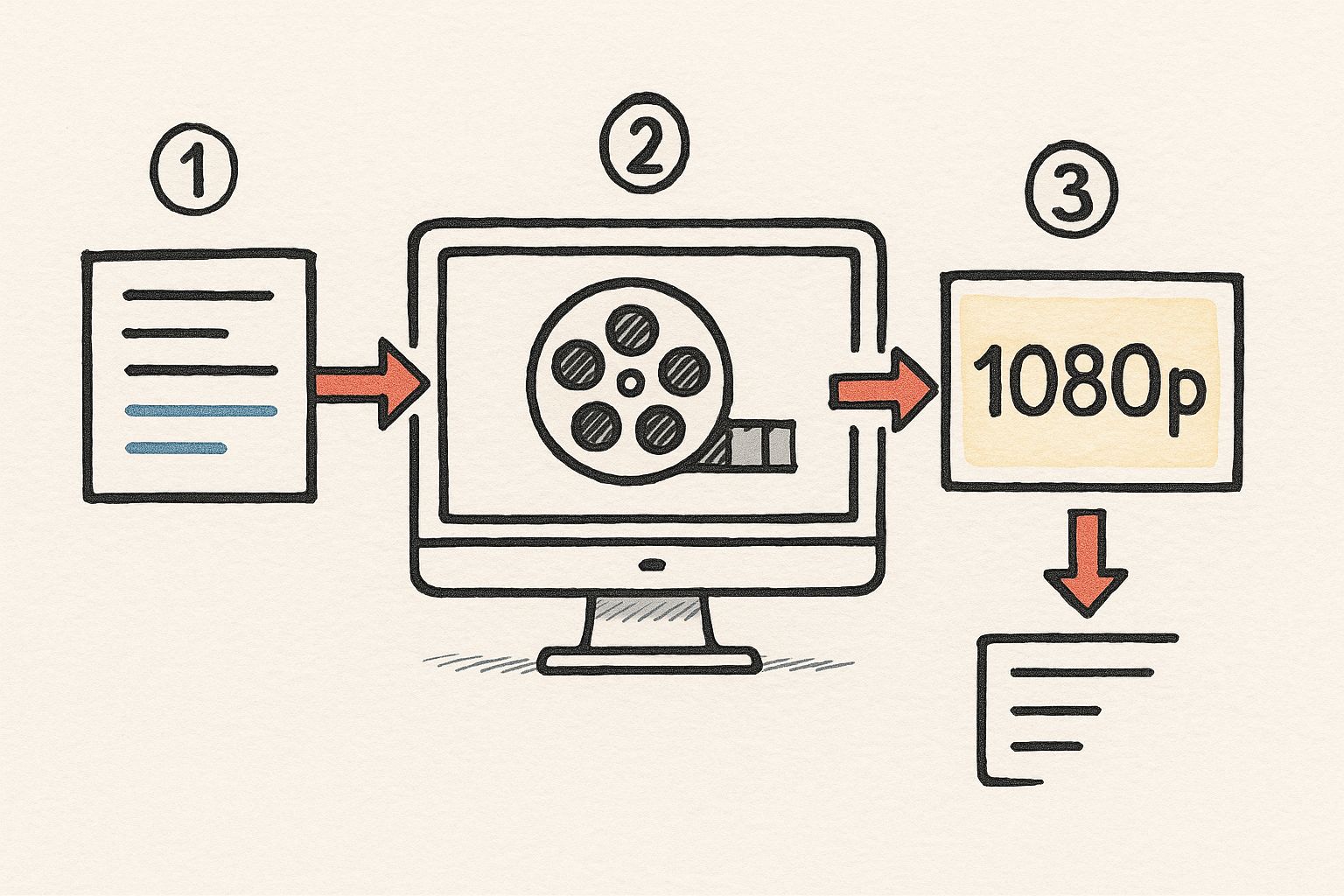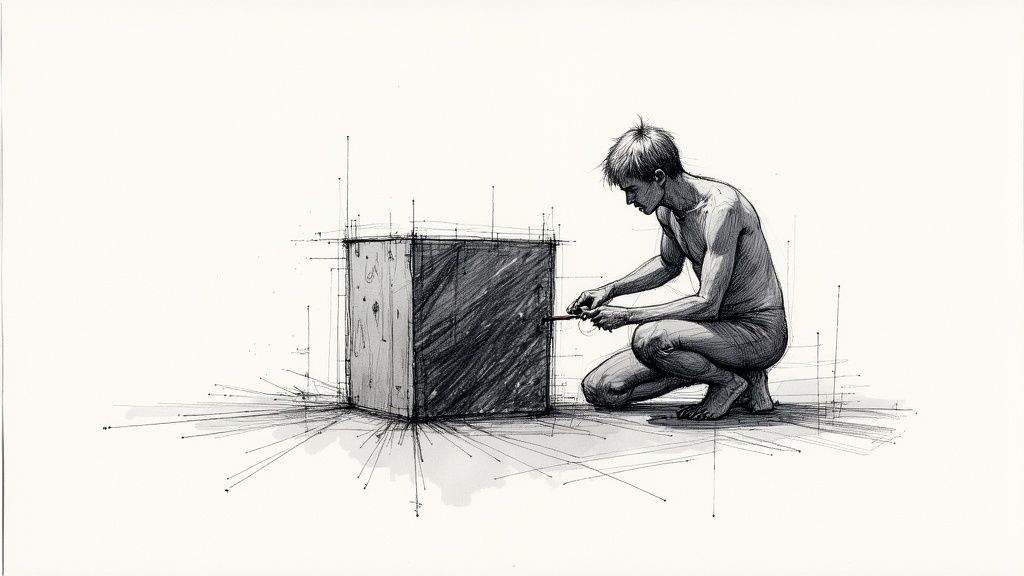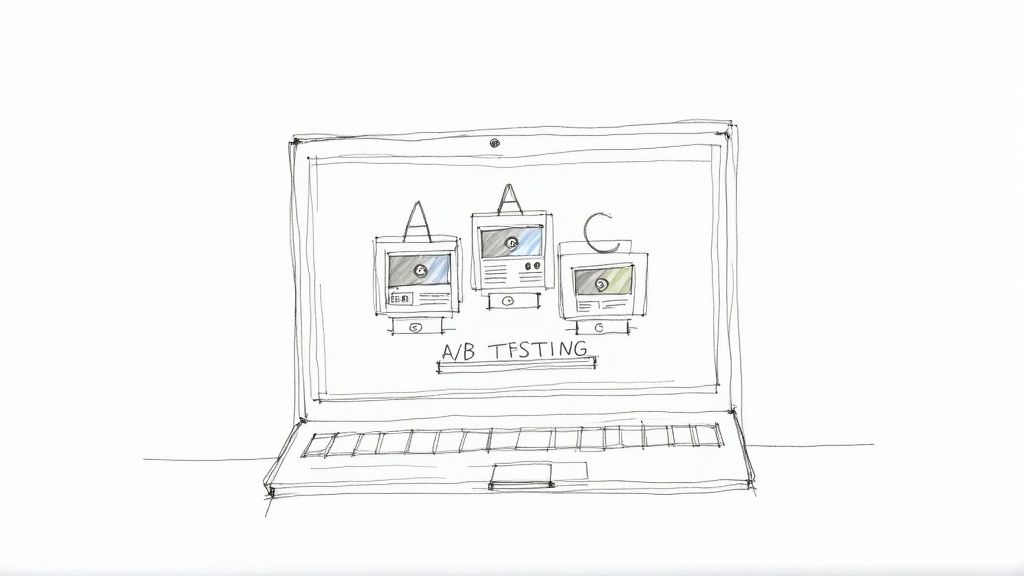- Блог
- Google Veo3.1: что нужно знать
Google Veo3.1: что нужно знать
Google Veo3.1 — последняя и самая мощная модель ИИ компании для превращения идей — будь то текст или изображения — в впечатляющие видеоролики высокой четкости. Думайте о ней не как об инструменте, а как о творческом партнёре, который наконец-то понимает сложные замыслы и переводит их в видео 1080p с выразительной кинематографичностью.
Что особенного в Veo3.1?
В основе Veo3.1 — решение давней задачи в создании контента: как сделать профессиональное видео быстро, доступно и без дорогостоящей команды. Мы знаем, сколько времени, навыков и денег требуется, чтобы снять даже короткий ролик. Veo3.1 переписывает эти правила, по сути превращая ваш компьютер в виртуальную продакшн‑студию.
Это значит, что маркетологи, режиссёры и креаторы могут миновать технические сложности и сразу погружаться в сторителлинг. Представьте: за время, пока вы берёте кофе, — сгенерировать десяток концепций для A/B‑тестов. Или визуализировать сложную сцену фильма без съёмочной группы. Возможности действительно меняют правила игры.
Эта инфографика наглядно показывает, как Veo3.1 превращает простой текстовый запрос в отполированный HD‑ролик.

Как видно, модель упрощает весь творческий процесс — от идеи в голове до готового видео на экране.
В чём отличие?
Что делает Veo3.1 особенной «под капотом»? Это большой шаг вперёд в ИИ‑видео, основанный на сочетании продвинутых моделей Transformer и методов латентной диффузии. Но главный секрет — обучающие данные: обширный проприетарный датасет из экосистемы Google, включая YouTube, Google Поиск и DeepMind.
Такое обучение позволяет Veo3.1 делать невероятные вещи. Она генерирует видео 1080p с нативным звуком, правдоподобной синхронизацией губ и эффектами, которые соответствуют сцене. Модель может оживить одно статичное изображение в 8‑секундный клип. Более подробный разбор этого рубежа в ИИ‑видеогенерации читайте на comfyonline.app.
Речь не просто об автоматизации. Речь о том, чтобы дать авторам возможность создавать визуал, который не только технически точен, но и контекстно умен и эмоционально вовлекает.
Кому это выгоднее всего?
- Маркетологи: Могут штамповать вариации реклам и контент для соцсетей в невероятном темпе.
- Кинематографисты: Получают инструмент для быстрого сторибординга и визуализации сцен до начала съёмок.
- Преподаватели: Делают наглядные учебные материалы без большого бюджета и дорогого оборудования.
- Малый бизнес: Создаёт профессиональные продуктовые видео, ранее недоступные по стоимости.
Как ИИ превращает идеи в видео
Как из одной фразы рождается яркое движущееся видео? Технология Veo3.1 кажется магией, но за ней — удачное сочетание ИИ‑подходов. Всё начинается с латентной диффузионной модели.
Представьте цифрового скульптора. Он начинает не с чистого листа, а с блока «цифрового шума» — как рябь на старом телевизоре. Ваш текстовый промпт — это резец: он задаёт точные указания, по которым ИИ постепенно «снимает» шум, пока не проявится сцена.
Важно не просто распознать слова. ИИ понимает целостную идею. Он отличает «собака» от «золотистого ретривера, радостно гоняющегося за красным мячом в солнечном парке». Он переводит настроение и детали ваших слов в связную визуальную картину.
Сшивание цельной истории
Сделать один отличный кадр — одно. Собрать из них логичное видео — совсем другое. Здесь вступает архитектура Transformer, выступая режиссёром процесса.
Transformer читает промпт: сюжет, контекст и важные мелочи. Он следит, чтобы герой, вошедший в комнату, оставался тем же героем через несколько секунд. Благодаря этому Veo3.1 создаёт последовательные ролики, где объекты не исчезают и не меняют цвет между кадрами.
Именно такое понимание «потока» придаёт результату отполированный, кинематографичный вид. Подробнее о процессе — на https://www.veo3ai.io/text-to-video.
Главная задача — превратить абстрактный язык в конкретные движущиеся образы. Veo3.1 понимает не только слова, но и стоящую за ними историю, чтобы воплотить вашу задумку.
Обучение на реальном мире
Откуда ИИ знает, как выглядит, ощущается и звучит дождливый день? Он учится, как и мы, — наблюдая. Google обучила Veo3.1 на огромной библиотеке видео и аудио, значительная часть — с YouTube.

Этот массив данных научил модель всему — от физики прыгающего мяча до тонкой игры света от свечи.
Поэтому инструмент генерирует идеально синхронизированный звук. Попросите «дождь по жестяной крыше» — получите и визуал, и узнаваемое кап-кап. Многослойный подход делает результат правдоподобным и погружающим. А чтобы понять контекст шире, посмотрите, как ИИ встраивается в постпродакшн и меняет работу креаторов.
Что отличает Veo3.1?
ИИ‑видео давно интересно, но с Veo3.1 технология перестаёт быть новинкой и становится полноценным творческим партнёром. Здесь не косметические правки, а фундаментальные улучшения, решающие главные проблемы прошлых моделей и дающие реальный контроль.
Первое, что бросается в глаза, — переход к полноценному 1080p. Это важно: ролики сразу получаются чёткими и пригодными для профессионального использования. Фазе «мыльных превью» можно сказать «прощай».
С такой чёткостью Veo3.1 становится претендентом на финальный монтаж — будь то реклама для соцсетей или хиро‑видео для сайта. Детали из промпта — фактура куртки, блики на воде — наконец отображаются с нужной точностью.
Иммерсивный звук и реально работающая озвучка
Вот настоящий прорыв: родная генерация аудио с точной синхронизацией губ. Это меняет всё. Veo3.1 не просто накладывает стоковую музыку — она строит звуковую сцену, соответствующую кадру.
Представьте оживлённую улицу: видите не только картинку, но и слышите низкий гул трафика, далёкую сирену, гул толпы. А когда герой говорит, его губы совпадают со словами. Раньше это было большой проблемой для ИИ‑видео, а теперь открывает новые возможности сторителлинга и маркетинга без отдельной аудиокоманды.
Благодаря нативному звуку Veo3.1 создаёт целый мир, а не «немое кино». Она понимает, что слышимое так же важно, как видимое, и формирует по‑настоящему иммерсивный опыт.
Оживление статичных изображений
Ещё один сильный инструмент Veo3.1 — image‑to‑video. Возьмите статичное фото или рисунок, загрузите — и ИИ оживит его в короткий динамичный клип. Модель достаточно умна, чтобы понять, какое движение здесь будет естественным.
Это практично для многого:
- Анимация логотипов: Превратите статичный логотип компании в стильный интро‑ролик.
- Оживление иллюстраций: Если вы цифровой художник, добавьте лёгкое движение для более вовлекающих постов.
- Усиление товарных кадров: Чистый продуктовый снимок для e‑commerce может стать быстрым, заметным объявлением.
Функция помогает извлекать больше пользы из уже имеющихся ассетов. А дальше можно сочетать AI‑клипы с продвинутыми эффектами видеомонтажа для максимально отполированного результата. Баланс генерации ИИ и творческого контроля — то, что выделяет Veo3.1.
Чтобы понять масштаб прогресса, сравним Veo3.1 с предыдущим поколением инструментов.
Улучшения функций и производительности в Veo3.1
| Feature | Previous Standard (e.g., Veo 2.x) | Veo3.1 Enhancement | Practical Impact |
|---|---|---|---|
| Разрешение видео | Обычно ограничено 720p и ниже; часто «мыло». | Полный 1080p HD на выходе. | Чёткое, профессиональное видео, готовое к публикации. |
| Генерация аудио | Отдельный TTS или без звука. | Интегрированное, контекстное аудио и саундскейпы. | Полностью погружающая сцена с реалистичным окружением. |
| Синхронизация речи | Отсутствует; губы статичны или случайны. | Точная синхронизация губ с речью. | Достоверные говорящие персонажи для историй. |
| Реалистичность движения | Дёрганые, неестественные движения. | Более плавная и стабильная динамика и физика. | Ролики выглядят живее и меньше «похожи на ИИ». |
| Интеграция ассетов | В основном только text‑to‑video. | Image‑to‑video анимация. | Повторное использование фото и иллюстраций в видео. |
Как видно, скачок от старых моделей к Veo3.1 — это не небольшие апдейты, а серьёзные шаги, решающие реальные задачи создателей.
Практические сценарии для маркетологов и креаторов
Техспеки впечатляют, но что даёт эта мощь на практике? Здесь начинается главное. Для маркетологов и контент‑команд это не очередная «игрушка», а инструмент, радикально ускоряющий работу и расширяющий возможности.
Допустим, вы запускаете продукт. Раньше — недели планирования, съёмок и монтажа ради одной‑двух версий рекламы. Теперь — десятки качественных вариаций за минуты. Можно почти мгновенно A/B‑тестировать заходы, визуал и призывы к действию, оптимизируя кампанию по данным.
Полезно и для внутренних коммуникаций: можно быстро делать обучающие ролики или корпоративные объявления без найма съёмочной группы. Сухие рассылки превращаются в динамичные визуальные апдейты, которые хочется смотреть.

Масштабирование контента на уровне предприятия
Для крупных компаний главное — как Veo3.1 интегрируется с Vertex AI в Google Cloud. Это не про «разовый ролик», а про масштабируемый, консистентный видеопайплайн. Можно задать бренд‑гайд — цвета, логотипы, тон — и получать ролики, которые звучат именно как вы.
Veo3.1 — не про «единичное видео». Это про выстраивание стабильной, масштабируемой визуальной коммуникации — от глобальных кампаний до гипертаргетированных постов.
Такой контроль критичен для сохранения бренда при темпах публикации, немыслимых ещё недавно.
Трансформация глобальных маркетинговых кампаний
Одна из сильных сторон Veo3.1 — локализация. Она поддерживает десятки языков, позволяя создать один ролик и адаптировать его под рынки без долгого и дорогого дубляжа и субтитров. Рост рынка ИИ‑видео смотрите на MarketsandMarkets.com.
Глобальный маркетинг из логистического кошмара превращается в отлаженный и экономичный процесс. Бренд запускает синхронизированную мировую кампанию, где сообщение точно резонирует локально. Для понимания экосистемы посмотрите гид по топовым AI‑инструментам для контента — он помогает увидеть современный набор креатора.
Роль Veo3.1 в глобальной гонке ИИ‑видео
Инструменты вроде Veo3.1 не появляются из ниоткуда. Это продуманный шаг в конкурентной сфере ИИ‑видео, рынок которой стремительно растёт. Речь не просто о «крутой технологии», а о борьбе за лидерство — стратегия Google с поэтапным международным запуском это подтверждает.
Это видно по быстрому присутствию в ключевых тех‑хабах. После релиза Google Veo3.1 активно набирает аудиторию в Южной Корее, Японии, Индии, Германии, Франции и Испании. Это не только «рост пользователей», а фокус на создателях в влиятельных регионах Азии и Европы. Подробнее об экспансии — в разборе на Reelmind.ai.
Конкурентная среда
Важно понимать: Veo3.1 — не единственный игрок. Другие лидеры тоже переосмысливают генеративное видео. Преимущество Google — не в одной «убийственной фиче», а в бесшовной интеграции с экосистемой, особенно с Vertex AI от Google Cloud.
Это даёт бизнесу масштаб и консистентность, которые трудно повторить «стэндэлон»‑инструментам. Важно не просто сделать классный клип, а выстроить надёжный конвейер контента — именно это нужно enterprise‑клиентам.
Битва за лидерство в ИИ‑видео решится не «галочками в фичах», а тем, кто лучше встроится в существующие креативные и бизнес‑процессы — от идеи до финального продукта.
Ответственное использование ИИ
Большая креативная мощь требует ответственности. Рост синтетических медиа вызывает опасения — дипфейки, дезинформация. Google решает это, встраивая защиту прямо в Veo3.1.
Ключевой элемент — SynthID, невидимая цифровая водяная марка. Она метит любой сгенерированный контент так, что её трудно удалить, помогая отличать синтетику. Это важный шаг к прозрачности и доверии, когда такие инструменты входят в повседневность.
Начало работы с Veo3.1
https://www.youtube.com/embed/FMdIIBByNZo
Довольно теории — перейдём к практике. Доступ к Veo3.1 зависит от того, кто вы — бизнес или независимый создатель.
Для профессиональных команд основной путь — Vertex AI в Google Cloud. Он даёт масштаб и интеграции для серьёзных проектов. Для остальных — индивидуальных авторов и небольших студий — доступ постепенно появляется на разных платформах и по подписке.
Главное — не просто получить доступ, а научиться формулировать промпты так, чтобы ИИ собирал именно то, что у вас в голове.
Искусство написания промптов
Качество видео напрямую отражает качество промпта. Чем конкретнее — тем лучше.
Не пишите «машина едет». Это может быть что угодно. Лучше так: «винтажный красный кабриолет едет по извилистой прибрежной дороге на закате, золотистый свет отражается в хроме». Чувствуете разницу?
Думайте как режиссёр. Дайте ИИ чёткие указания по:
- Сюжету и действию: Кто и что делает? Будьте точны.
- Сеттингу и окружению: Опишите место, время суток, погоду.
- Настроению и стилю: «Мечтательный», «динамичный», «ностальгический», «футуристичный» и т. п.
- Киноязыку: Просите «аэрошот», «таймлапс» или «долли‑зум».
Эффективный промпт — это диалог. Начните с чёткого замысла, посмотрите ответ Veo3.1 и корректируйте. С каждым шагом вы ближе к идеальному кадру.
Хотите глубже? Ознакомьтесь с гайдом о том, как создавать AI‑видео с продвинутыми техниками промптинга.
Практические моменты использования
Прежде чем погружаться, продумайте практику. Использование Veo3.1 через платформы вроде Vertex AI обычно тарифицируется по объёму, поэтому важно сверить бюджет проекта.
Параллельно следите за временем генерации и возможными лимитами пакета. Раннее понимание этих деталей поможет оценить, насколько Veo3.1 вписывается в ваш рабочий процесс и цели.
Вопросы о Google Veo3.1?
Когда появляется такой многообещающий инструмент, как Google Veo3.1, вопросов много: что он умеет, для кого он и в чём подвох. Разберём частые.
Кто может получить доступ? Сейчас Google открывает Veo3.1 поэтапно. Основной вход — через Vertex AI в Google Cloud для enterprise‑клиентов и профкоманд. Но доступ для независимых создателей постепенно появляется на разных платформах.
Итак, Veo3.1 бесплатен?
Это главный вопрос. Возможны ограниченные бесплатные пробы, но полная версия Veo3.1 — особенно интегрированная в Vertex AI — предоставляется на платной основе. Ценообразование ориентировано на профессиональное использование, где экономия времени и качество окупают инвестиции.
Чем Veo3.1 отличается от десятков других ИИ‑инструментов? Ключевые преимущества:
- Настоящий 1080p‑выход: Это не «апскейл». Veo3.1 генерирует чёткий HD‑контент сразу.
- Встроенная генерация аудио: Это не «немое кино». Модель создаёт синхронизированные эффекты и может озвучивать речь, экономя массу времени.
- Глубокая интеграция в экосистему: Семейство Vertex AI — это масштаб и консистентность. Речь о стабильном бренд‑пайплайне, а не разовых экспериментах.
Магия Veo3.1 не в том, что она просто «делает видео», а в том, что она создаёт почти готовый аудиовизуальный пакет, минимизируя постпродакшн — инструмент для серьёзных авторов.
И наконец, права. Обычно вы получаете права на итоговый ролик, созданный в Veo3.1. Это значит, что можете использовать его в личных и коммерческих проектах — уверенно строя бренд на ИИ‑медиа.
Готовы оживить идеи? Начните создавать профессиональные видео из простого текста или изображений за считаные минуты с Veo3 AI. Зайдите на https://veo3ai.io и попробуйте бесплатно уже сегодня.
Article created using Outrank
